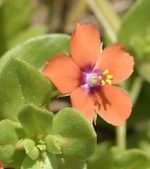 Scarlet pimpernel is an annual native to Europe, western Asia and North Africa but was widely introduced as an ornamental and is now is found in throughout the US. Although it prefers full sun and sandy soil it tolerates less and grows in farmlands, fields, and gardens as well as along roadsides and seashores. It is a member of the primrose family, Primulaceae, that also includes cyclamen, loosestrife, and shooting star. Other common names include poor-man’s weatherglass, poor-man’s barometer, and shepherd’s clock that refer to the fact that the flowers open only when the sun shines.
Scarlet pimpernel is an annual native to Europe, western Asia and North Africa but was widely introduced as an ornamental and is now is found in throughout the US. Although it prefers full sun and sandy soil it tolerates less and grows in farmlands, fields, and gardens as well as along roadsides and seashores. It is a member of the primrose family, Primulaceae, that also includes cyclamen, loosestrife, and shooting star. Other common names include poor-man’s weatherglass, poor-man’s barometer, and shepherd’s clock that refer to the fact that the flowers open only when the sun shines.
Description: Growing 4-12″ tall, scarlet pimpernel has a weak sprawling stem that is square in cross-section and carries bright green, oval, sessile, leaves up to 1″ long. Star-shaped flowers 1/4′ across appear singly in leaf axils on nodding stems in summer and may be white, blue, orange, or red. The fruits are tiny round capsules that hang from curved stalks and contain several egg to football-shaped black or brown seeds covered with wart-like projections.
Control: Mulch to prevent existing seeds from sprouting and hoe, or pull seedlings as they appear. Pull, cut, or mow larger plants before seed set which will eliminate the weed in the future because it is an annual and spreads by seeds. Improving the water carrying capacity of the soil by adding organic matter will discourage the growth of scarlet pimpernel and foster the growth of more favorable plants.